Detailed Management Accounting Report for BTEC HND Unit 5
VerifiedAdded on 2023/01/10
|21
|4680
|82
Report
AI Summary
This report provides a comprehensive overview of management accounting, exploring its role, systems, and techniques. It begins with an introduction to management accounting, emphasizing its importance in providing financial information for decision-making, planning, and control within organizations. The report then delves into the role of management accounting, highlighting its key functions, including planning, developing management information systems, maintaining capital structure, participating in management processes, and decision-making. Different methods used in management accounting reporting are discussed, such as debtors/accounts receivable aging reports, departmental reports, performance reports, and operating budget reports. The report uses Tesco as a case study, exploring the application and benefits of various management accounting systems, including cost accounting, job costing, and inventory management. The report also applies a range of management accounting techniques, including marginal and absorption costing, and provides an analysis of their application in preparing financial statements. Finally, the report examines planning tools used in management accounting, including budgetary control, and discusses their advantages and disadvantages. The report concludes with a summary of the key concepts and findings.
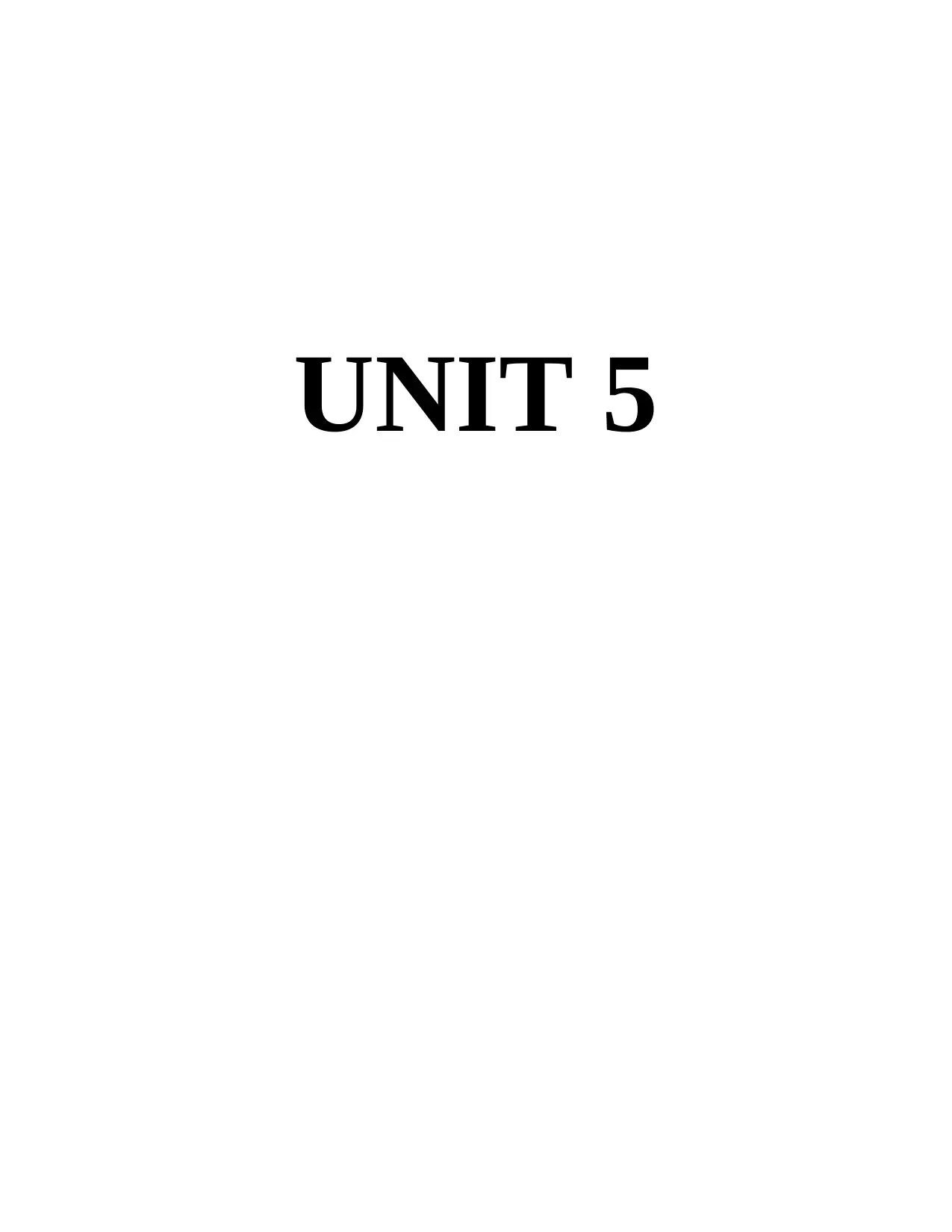
UNIT 5
Paraphrase This Document
Need a fresh take? Get an instant paraphrase of this document with our AI Paraphraser
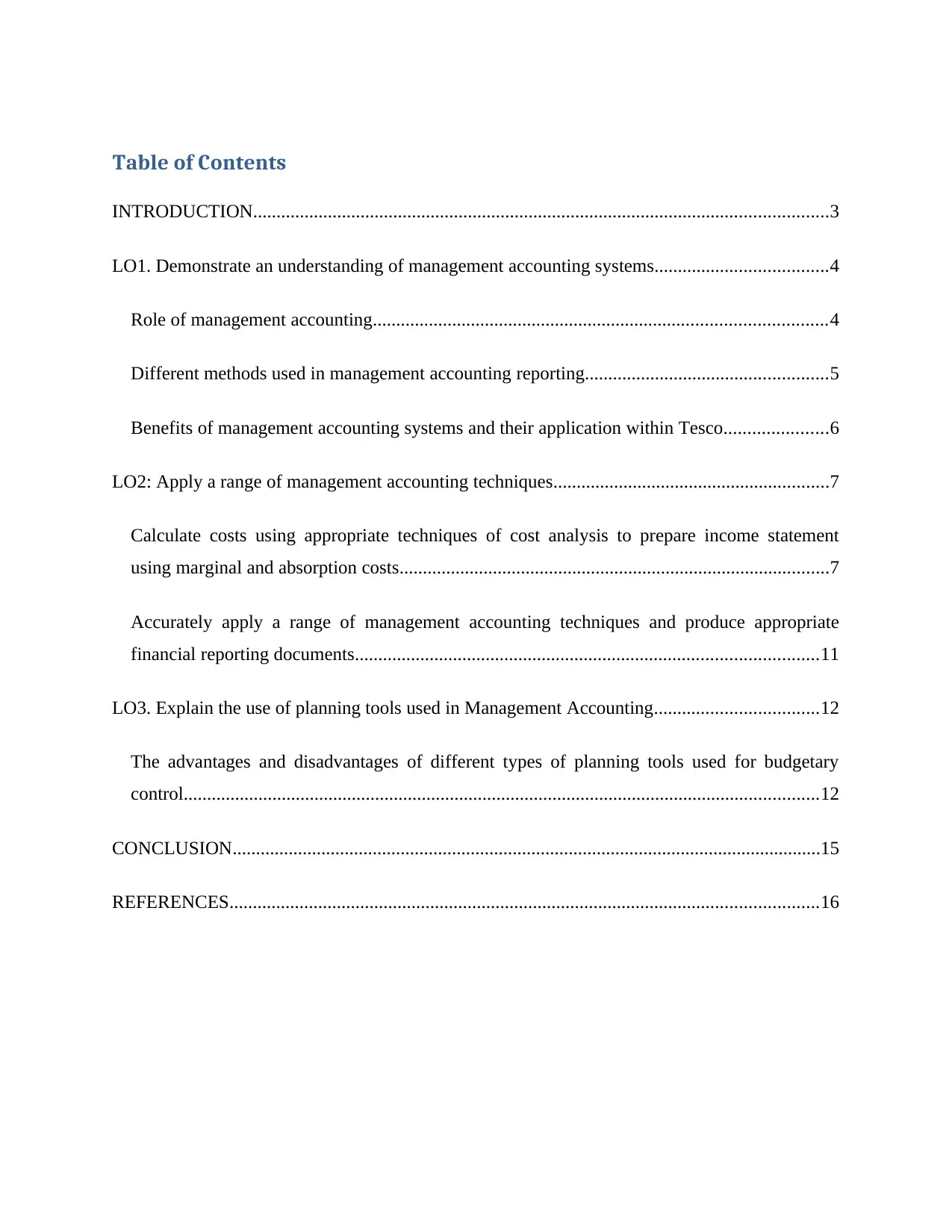
Table of Contents
INTRODUCTION...........................................................................................................................3
LO1. Demonstrate an understanding of management accounting systems.....................................4
Role of management accounting.................................................................................................4
Different methods used in management accounting reporting....................................................5
Benefits of management accounting systems and their application within Tesco......................6
LO2: Apply a range of management accounting techniques...........................................................7
Calculate costs using appropriate techniques of cost analysis to prepare income statement
using marginal and absorption costs............................................................................................7
Accurately apply a range of management accounting techniques and produce appropriate
financial reporting documents...................................................................................................11
LO3. Explain the use of planning tools used in Management Accounting...................................12
The advantages and disadvantages of different types of planning tools used for budgetary
control........................................................................................................................................12
CONCLUSION..............................................................................................................................15
REFERENCES..............................................................................................................................16
INTRODUCTION...........................................................................................................................3
LO1. Demonstrate an understanding of management accounting systems.....................................4
Role of management accounting.................................................................................................4
Different methods used in management accounting reporting....................................................5
Benefits of management accounting systems and their application within Tesco......................6
LO2: Apply a range of management accounting techniques...........................................................7
Calculate costs using appropriate techniques of cost analysis to prepare income statement
using marginal and absorption costs............................................................................................7
Accurately apply a range of management accounting techniques and produce appropriate
financial reporting documents...................................................................................................11
LO3. Explain the use of planning tools used in Management Accounting...................................12
The advantages and disadvantages of different types of planning tools used for budgetary
control........................................................................................................................................12
CONCLUSION..............................................................................................................................15
REFERENCES..............................................................................................................................16
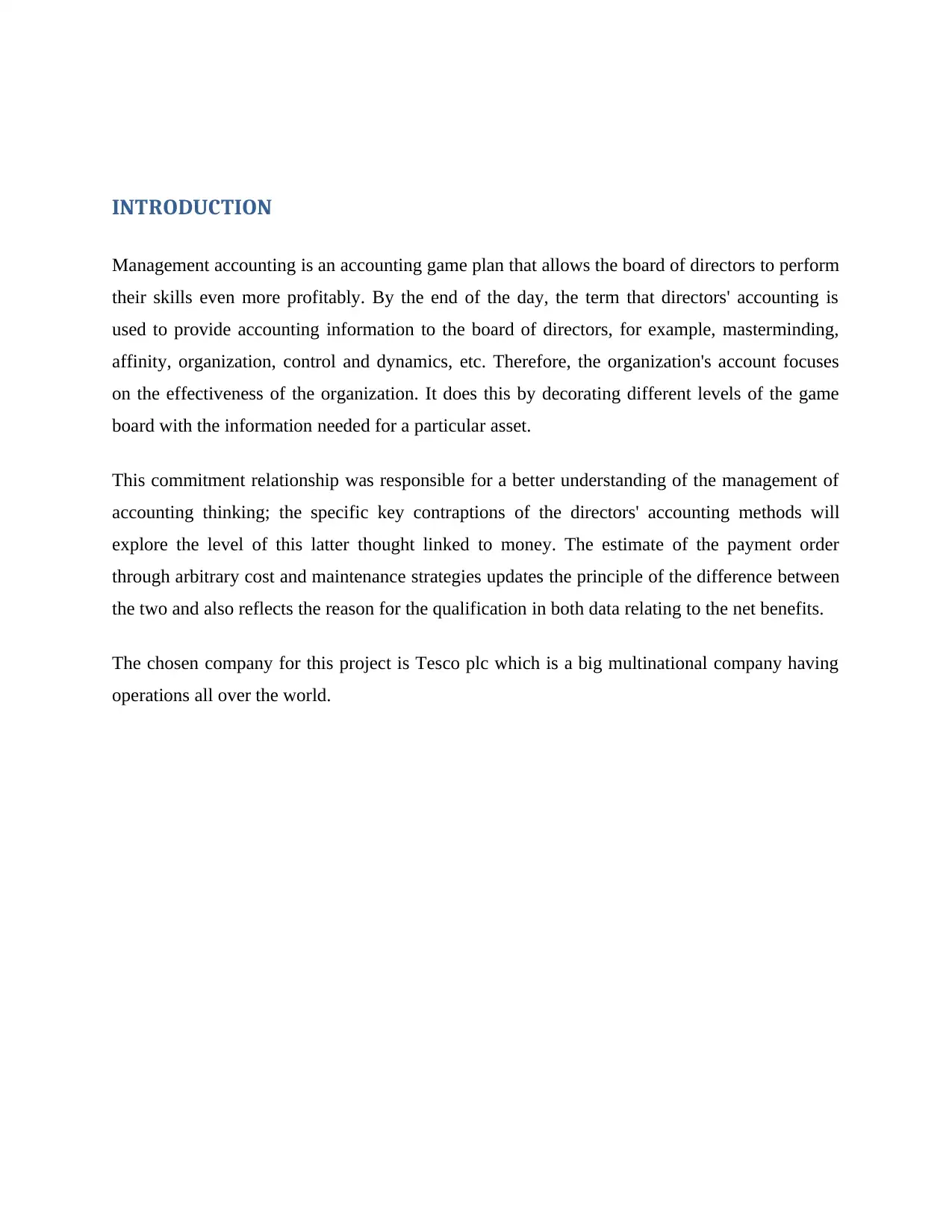
INTRODUCTION
Management accounting is an accounting game plan that allows the board of directors to perform
their skills even more profitably. By the end of the day, the term that directors' accounting is
used to provide accounting information to the board of directors, for example, masterminding,
affinity, organization, control and dynamics, etc. Therefore, the organization's account focuses
on the effectiveness of the organization. It does this by decorating different levels of the game
board with the information needed for a particular asset.
This commitment relationship was responsible for a better understanding of the management of
accounting thinking; the specific key contraptions of the directors' accounting methods will
explore the level of this latter thought linked to money. The estimate of the payment order
through arbitrary cost and maintenance strategies updates the principle of the difference between
the two and also reflects the reason for the qualification in both data relating to the net benefits.
The chosen company for this project is Tesco plc which is a big multinational company having
operations all over the world.
Management accounting is an accounting game plan that allows the board of directors to perform
their skills even more profitably. By the end of the day, the term that directors' accounting is
used to provide accounting information to the board of directors, for example, masterminding,
affinity, organization, control and dynamics, etc. Therefore, the organization's account focuses
on the effectiveness of the organization. It does this by decorating different levels of the game
board with the information needed for a particular asset.
This commitment relationship was responsible for a better understanding of the management of
accounting thinking; the specific key contraptions of the directors' accounting methods will
explore the level of this latter thought linked to money. The estimate of the payment order
through arbitrary cost and maintenance strategies updates the principle of the difference between
the two and also reflects the reason for the qualification in both data relating to the net benefits.
The chosen company for this project is Tesco plc which is a big multinational company having
operations all over the world.
⊘ This is a preview!⊘
Do you want full access?
Subscribe today to unlock all pages.

Trusted by 1+ million students worldwide
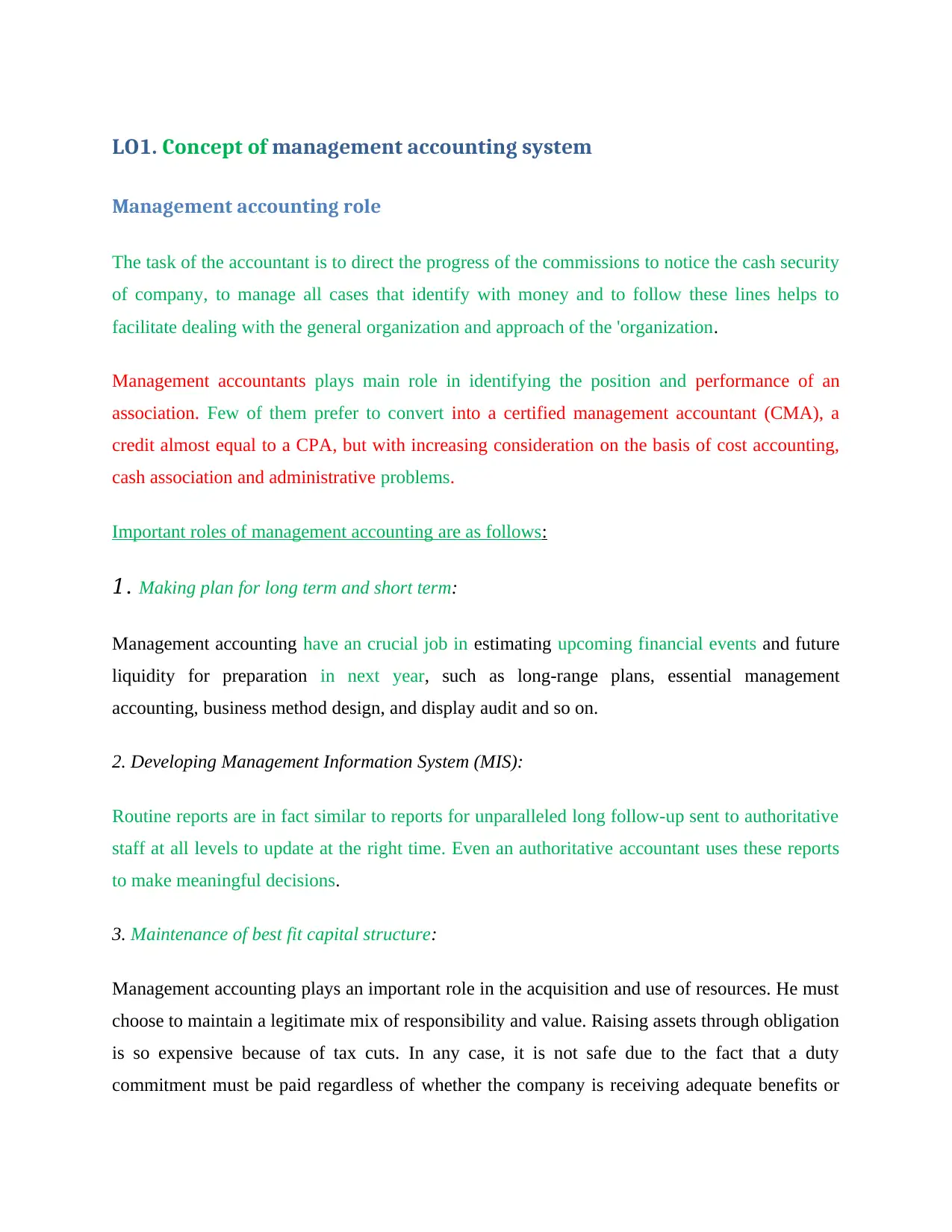
LO1. Concept of management accounting system
Management accounting role
The task of the accountant is to direct the progress of the commissions to notice the cash security
of company, to manage all cases that identify with money and to follow these lines helps to
facilitate dealing with the general organization and approach of the 'organization.
Management accountants plays main role in identifying the position and performance of an
association. Few of them prefer to convert into a certified management accountant (CMA), a
credit almost equal to a CPA, but with increasing consideration on the basis of cost accounting,
cash association and administrative problems.
Important roles of management accounting are as follows:
1. Making plan for long term and short term:
Management accounting have an crucial job in estimating upcoming financial events and future
liquidity for preparation in next year, such as long-range plans, essential management
accounting, business method design, and display audit and so on.
2. Developing Management Information System (MIS):
Routine reports are in fact similar to reports for unparalleled long follow-up sent to authoritative
staff at all levels to update at the right time. Even an authoritative accountant uses these reports
to make meaningful decisions.
3. Maintenance of best fit capital structure:
Management accounting plays an important role in the acquisition and use of resources. He must
choose to maintain a legitimate mix of responsibility and value. Raising assets through obligation
is so expensive because of tax cuts. In any case, it is not safe due to the fact that a duty
commitment must be paid regardless of whether the company is receiving adequate benefits or
Management accounting role
The task of the accountant is to direct the progress of the commissions to notice the cash security
of company, to manage all cases that identify with money and to follow these lines helps to
facilitate dealing with the general organization and approach of the 'organization.
Management accountants plays main role in identifying the position and performance of an
association. Few of them prefer to convert into a certified management accountant (CMA), a
credit almost equal to a CPA, but with increasing consideration on the basis of cost accounting,
cash association and administrative problems.
Important roles of management accounting are as follows:
1. Making plan for long term and short term:
Management accounting have an crucial job in estimating upcoming financial events and future
liquidity for preparation in next year, such as long-range plans, essential management
accounting, business method design, and display audit and so on.
2. Developing Management Information System (MIS):
Routine reports are in fact similar to reports for unparalleled long follow-up sent to authoritative
staff at all levels to update at the right time. Even an authoritative accountant uses these reports
to make meaningful decisions.
3. Maintenance of best fit capital structure:
Management accounting plays an important role in the acquisition and use of resources. He must
choose to maintain a legitimate mix of responsibility and value. Raising assets through obligation
is so expensive because of tax cuts. In any case, it is not safe due to the fact that a duty
commitment must be paid regardless of whether the company is receiving adequate benefits or
Paraphrase This Document
Need a fresh take? Get an instant paraphrase of this document with our AI Paraphraser
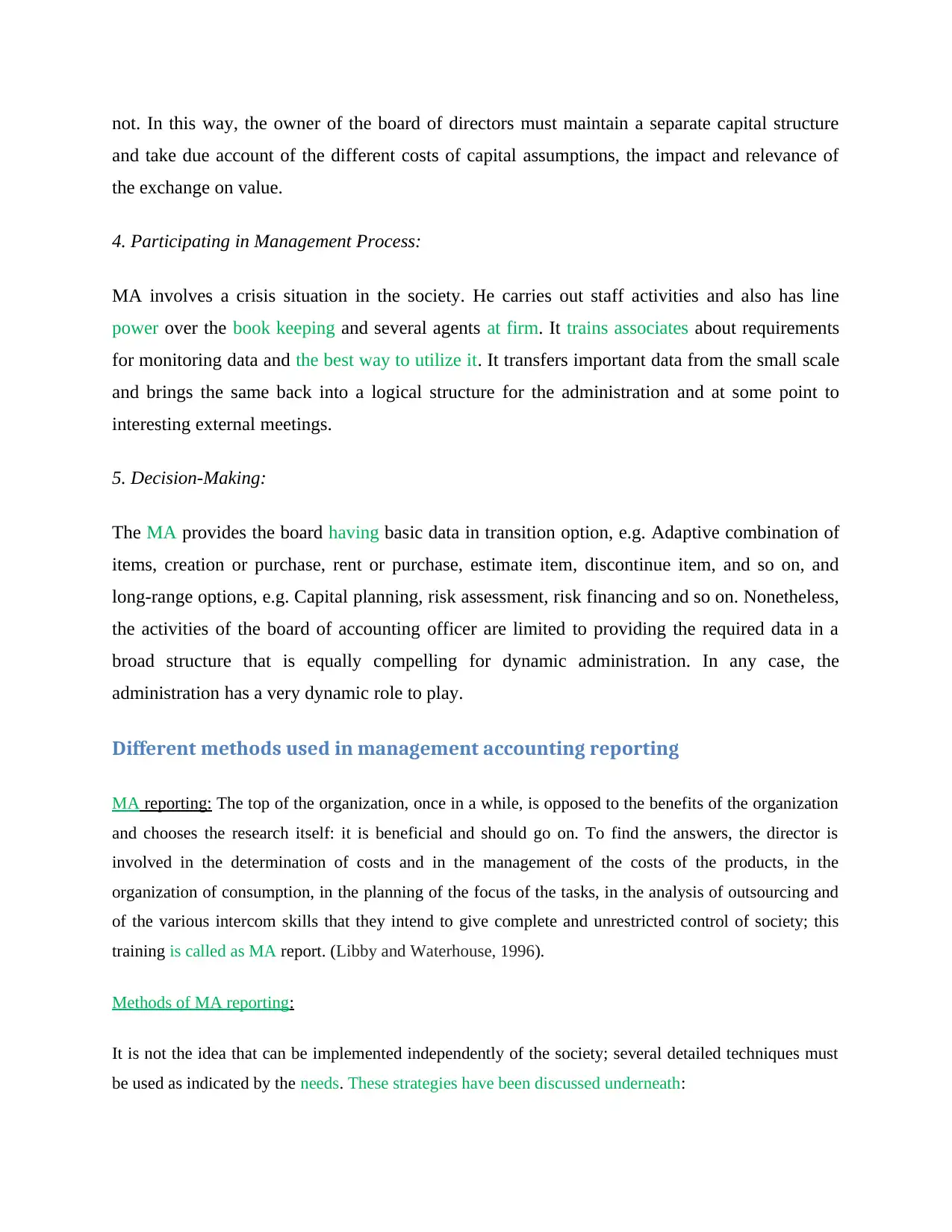
not. In this way, the owner of the board of directors must maintain a separate capital structure
and take due account of the different costs of capital assumptions, the impact and relevance of
the exchange on value.
4. Participating in Management Process:
MA involves a crisis situation in the society. He carries out staff activities and also has line
power over the book keeping and several agents at firm. It trains associates about requirements
for monitoring data and the best way to utilize it. It transfers important data from the small scale
and brings the same back into a logical structure for the administration and at some point to
interesting external meetings.
5. Decision-Making:
The MA provides the board having basic data in transition option, e.g. Adaptive combination of
items, creation or purchase, rent or purchase, estimate item, discontinue item, and so on, and
long-range options, e.g. Capital planning, risk assessment, risk financing and so on. Nonetheless,
the activities of the board of accounting officer are limited to providing the required data in a
broad structure that is equally compelling for dynamic administration. In any case, the
administration has a very dynamic role to play.
Different methods used in management accounting reporting
MA reporting: The top of the organization, once in a while, is opposed to the benefits of the organization
and chooses the research itself: it is beneficial and should go on. To find the answers, the director is
involved in the determination of costs and in the management of the costs of the products, in the
organization of consumption, in the planning of the focus of the tasks, in the analysis of outsourcing and
of the various intercom skills that they intend to give complete and unrestricted control of society; this
training is called as MA report. (Libby and Waterhouse, 1996).
Methods of MA reporting:
It is not the idea that can be implemented independently of the society; several detailed techniques must
be used as indicated by the needs. These strategies have been discussed underneath:
and take due account of the different costs of capital assumptions, the impact and relevance of
the exchange on value.
4. Participating in Management Process:
MA involves a crisis situation in the society. He carries out staff activities and also has line
power over the book keeping and several agents at firm. It trains associates about requirements
for monitoring data and the best way to utilize it. It transfers important data from the small scale
and brings the same back into a logical structure for the administration and at some point to
interesting external meetings.
5. Decision-Making:
The MA provides the board having basic data in transition option, e.g. Adaptive combination of
items, creation or purchase, rent or purchase, estimate item, discontinue item, and so on, and
long-range options, e.g. Capital planning, risk assessment, risk financing and so on. Nonetheless,
the activities of the board of accounting officer are limited to providing the required data in a
broad structure that is equally compelling for dynamic administration. In any case, the
administration has a very dynamic role to play.
Different methods used in management accounting reporting
MA reporting: The top of the organization, once in a while, is opposed to the benefits of the organization
and chooses the research itself: it is beneficial and should go on. To find the answers, the director is
involved in the determination of costs and in the management of the costs of the products, in the
organization of consumption, in the planning of the focus of the tasks, in the analysis of outsourcing and
of the various intercom skills that they intend to give complete and unrestricted control of society; this
training is called as MA report. (Libby and Waterhouse, 1996).
Methods of MA reporting:
It is not the idea that can be implemented independently of the society; several detailed techniques must
be used as indicated by the needs. These strategies have been discussed underneath:
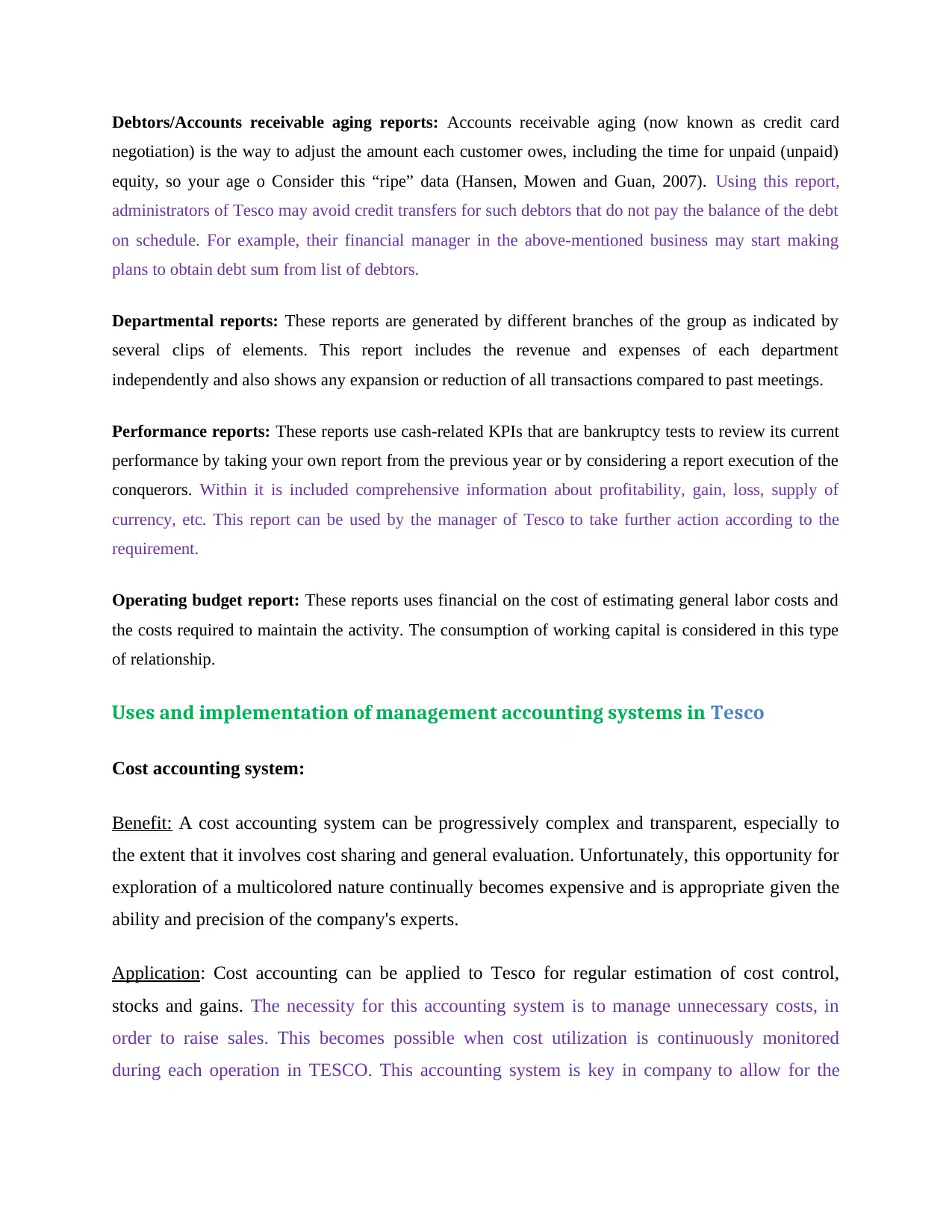
Debtors/Accounts receivable aging reports: Accounts receivable aging (now known as credit card
negotiation) is the way to adjust the amount each customer owes, including the time for unpaid (unpaid)
equity, so your age o Consider this “ripe” data (Hansen, Mowen and Guan, 2007). Using this report,
administrators of Tesco may avoid credit transfers for such debtors that do not pay the balance of the debt
on schedule. For example, their financial manager in the above-mentioned business may start making
plans to obtain debt sum from list of debtors.
Departmental reports: These reports are generated by different branches of the group as indicated by
several clips of elements. This report includes the revenue and expenses of each department
independently and also shows any expansion or reduction of all transactions compared to past meetings.
Performance reports: These reports use cash-related KPIs that are bankruptcy tests to review its current
performance by taking your own report from the previous year or by considering a report execution of the
conquerors. Within it is included comprehensive information about profitability, gain, loss, supply of
currency, etc. This report can be used by the manager of Tesco to take further action according to the
requirement.
Operating budget report: These reports uses financial on the cost of estimating general labor costs and
the costs required to maintain the activity. The consumption of working capital is considered in this type
of relationship.
Uses and implementation of management accounting systems in Tesco
Cost accounting system:
Benefit: A cost accounting system can be progressively complex and transparent, especially to
the extent that it involves cost sharing and general evaluation. Unfortunately, this opportunity for
exploration of a multicolored nature continually becomes expensive and is appropriate given the
ability and precision of the company's experts.
Application: Cost accounting can be applied to Tesco for regular estimation of cost control,
stocks and gains. The necessity for this accounting system is to manage unnecessary costs, in
order to raise sales. This becomes possible when cost utilization is continuously monitored
during each operation in TESCO. This accounting system is key in company to allow for the
negotiation) is the way to adjust the amount each customer owes, including the time for unpaid (unpaid)
equity, so your age o Consider this “ripe” data (Hansen, Mowen and Guan, 2007). Using this report,
administrators of Tesco may avoid credit transfers for such debtors that do not pay the balance of the debt
on schedule. For example, their financial manager in the above-mentioned business may start making
plans to obtain debt sum from list of debtors.
Departmental reports: These reports are generated by different branches of the group as indicated by
several clips of elements. This report includes the revenue and expenses of each department
independently and also shows any expansion or reduction of all transactions compared to past meetings.
Performance reports: These reports use cash-related KPIs that are bankruptcy tests to review its current
performance by taking your own report from the previous year or by considering a report execution of the
conquerors. Within it is included comprehensive information about profitability, gain, loss, supply of
currency, etc. This report can be used by the manager of Tesco to take further action according to the
requirement.
Operating budget report: These reports uses financial on the cost of estimating general labor costs and
the costs required to maintain the activity. The consumption of working capital is considered in this type
of relationship.
Uses and implementation of management accounting systems in Tesco
Cost accounting system:
Benefit: A cost accounting system can be progressively complex and transparent, especially to
the extent that it involves cost sharing and general evaluation. Unfortunately, this opportunity for
exploration of a multicolored nature continually becomes expensive and is appropriate given the
ability and precision of the company's experts.
Application: Cost accounting can be applied to Tesco for regular estimation of cost control,
stocks and gains. The necessity for this accounting system is to manage unnecessary costs, in
order to raise sales. This becomes possible when cost utilization is continuously monitored
during each operation in TESCO. This accounting system is key in company to allow for the
⊘ This is a preview!⊘
Do you want full access?
Subscribe today to unlock all pages.

Trusted by 1+ million students worldwide
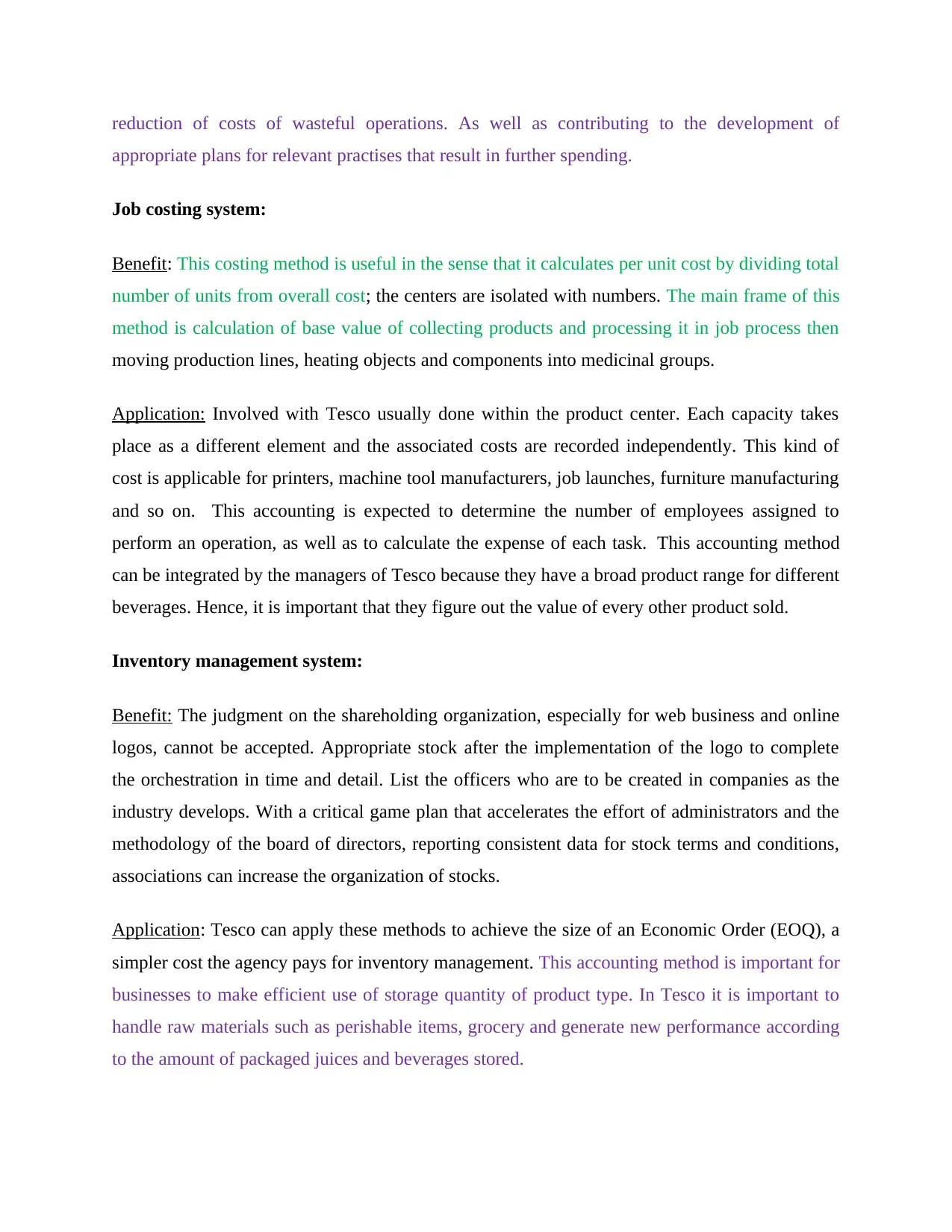
reduction of costs of wasteful operations. As well as contributing to the development of
appropriate plans for relevant practises that result in further spending.
Job costing system:
Benefit: This costing method is useful in the sense that it calculates per unit cost by dividing total
number of units from overall cost; the centers are isolated with numbers. The main frame of this
method is calculation of base value of collecting products and processing it in job process then
moving production lines, heating objects and components into medicinal groups.
Application: Involved with Tesco usually done within the product center. Each capacity takes
place as a different element and the associated costs are recorded independently. This kind of
cost is applicable for printers, machine tool manufacturers, job launches, furniture manufacturing
and so on. This accounting is expected to determine the number of employees assigned to
perform an operation, as well as to calculate the expense of each task. This accounting method
can be integrated by the managers of Tesco because they have a broad product range for different
beverages. Hence, it is important that they figure out the value of every other product sold.
Inventory management system:
Benefit: The judgment on the shareholding organization, especially for web business and online
logos, cannot be accepted. Appropriate stock after the implementation of the logo to complete
the orchestration in time and detail. List the officers who are to be created in companies as the
industry develops. With a critical game plan that accelerates the effort of administrators and the
methodology of the board of directors, reporting consistent data for stock terms and conditions,
associations can increase the organization of stocks.
Application: Tesco can apply these methods to achieve the size of an Economic Order (EOQ), a
simpler cost the agency pays for inventory management. This accounting method is important for
businesses to make efficient use of storage quantity of product type. In Tesco it is important to
handle raw materials such as perishable items, grocery and generate new performance according
to the amount of packaged juices and beverages stored.
appropriate plans for relevant practises that result in further spending.
Job costing system:
Benefit: This costing method is useful in the sense that it calculates per unit cost by dividing total
number of units from overall cost; the centers are isolated with numbers. The main frame of this
method is calculation of base value of collecting products and processing it in job process then
moving production lines, heating objects and components into medicinal groups.
Application: Involved with Tesco usually done within the product center. Each capacity takes
place as a different element and the associated costs are recorded independently. This kind of
cost is applicable for printers, machine tool manufacturers, job launches, furniture manufacturing
and so on. This accounting is expected to determine the number of employees assigned to
perform an operation, as well as to calculate the expense of each task. This accounting method
can be integrated by the managers of Tesco because they have a broad product range for different
beverages. Hence, it is important that they figure out the value of every other product sold.
Inventory management system:
Benefit: The judgment on the shareholding organization, especially for web business and online
logos, cannot be accepted. Appropriate stock after the implementation of the logo to complete
the orchestration in time and detail. List the officers who are to be created in companies as the
industry develops. With a critical game plan that accelerates the effort of administrators and the
methodology of the board of directors, reporting consistent data for stock terms and conditions,
associations can increase the organization of stocks.
Application: Tesco can apply these methods to achieve the size of an Economic Order (EOQ), a
simpler cost the agency pays for inventory management. This accounting method is important for
businesses to make efficient use of storage quantity of product type. In Tesco it is important to
handle raw materials such as perishable items, grocery and generate new performance according
to the amount of packaged juices and beverages stored.
Paraphrase This Document
Need a fresh take? Get an instant paraphrase of this document with our AI Paraphraser
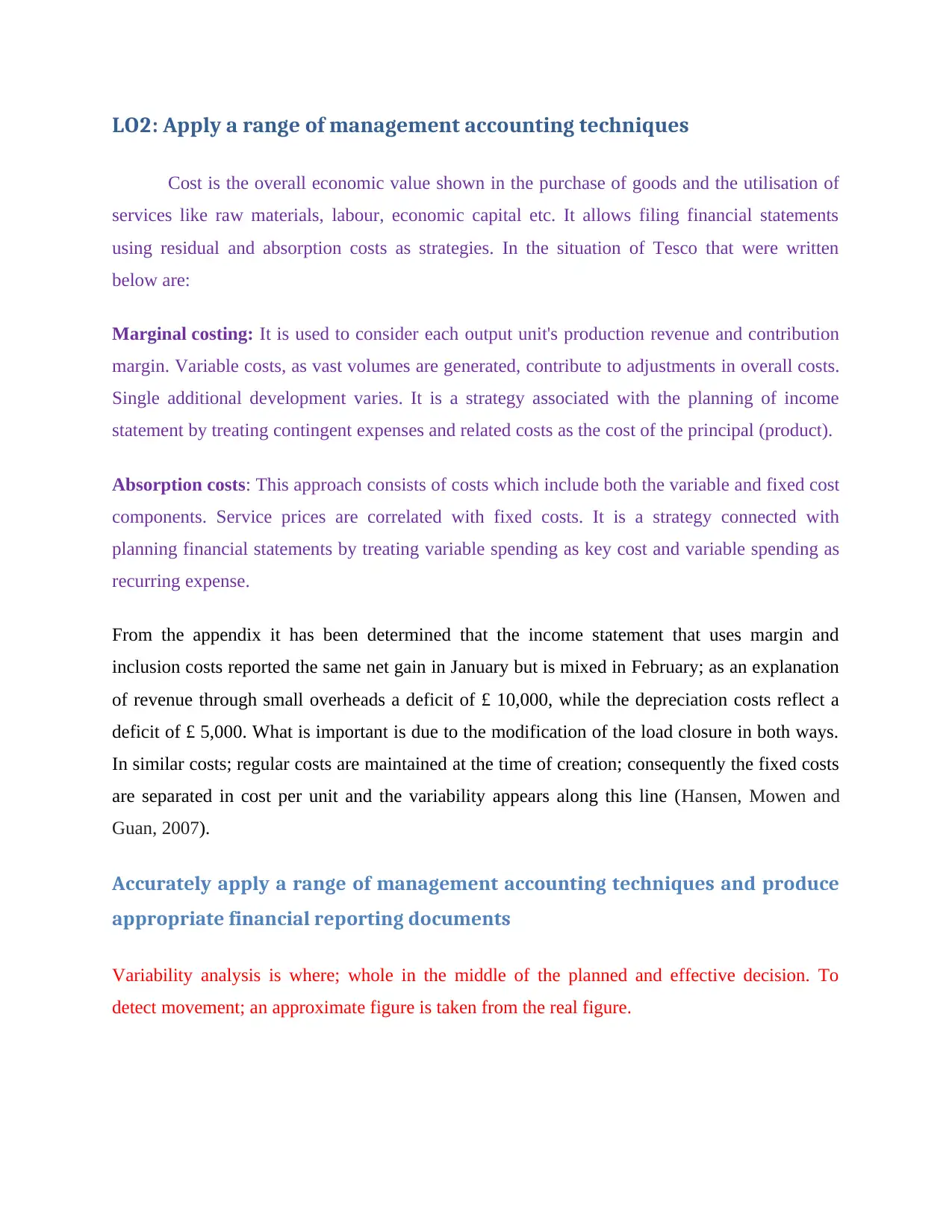
LO2: Apply a range of management accounting techniques
Cost is the overall economic value shown in the purchase of goods and the utilisation of
services like raw materials, labour, economic capital etc. It allows filing financial statements
using residual and absorption costs as strategies. In the situation of Tesco that were written
below are:
Marginal costing: It is used to consider each output unit's production revenue and contribution
margin. Variable costs, as vast volumes are generated, contribute to adjustments in overall costs.
Single additional development varies. It is a strategy associated with the planning of income
statement by treating contingent expenses and related costs as the cost of the principal (product).
Absorption costs: This approach consists of costs which include both the variable and fixed cost
components. Service prices are correlated with fixed costs. It is a strategy connected with
planning financial statements by treating variable spending as key cost and variable spending as
recurring expense.
From the appendix it has been determined that the income statement that uses margin and
inclusion costs reported the same net gain in January but is mixed in February; as an explanation
of revenue through small overheads a deficit of £ 10,000, while the depreciation costs reflect a
deficit of £ 5,000. What is important is due to the modification of the load closure in both ways.
In similar costs; regular costs are maintained at the time of creation; consequently the fixed costs
are separated in cost per unit and the variability appears along this line (Hansen, Mowen and
Guan, 2007).
Accurately apply a range of management accounting techniques and produce
appropriate financial reporting documents
Variability analysis is where; whole in the middle of the planned and effective decision. To
detect movement; an approximate figure is taken from the real figure.
Cost is the overall economic value shown in the purchase of goods and the utilisation of
services like raw materials, labour, economic capital etc. It allows filing financial statements
using residual and absorption costs as strategies. In the situation of Tesco that were written
below are:
Marginal costing: It is used to consider each output unit's production revenue and contribution
margin. Variable costs, as vast volumes are generated, contribute to adjustments in overall costs.
Single additional development varies. It is a strategy associated with the planning of income
statement by treating contingent expenses and related costs as the cost of the principal (product).
Absorption costs: This approach consists of costs which include both the variable and fixed cost
components. Service prices are correlated with fixed costs. It is a strategy connected with
planning financial statements by treating variable spending as key cost and variable spending as
recurring expense.
From the appendix it has been determined that the income statement that uses margin and
inclusion costs reported the same net gain in January but is mixed in February; as an explanation
of revenue through small overheads a deficit of £ 10,000, while the depreciation costs reflect a
deficit of £ 5,000. What is important is due to the modification of the load closure in both ways.
In similar costs; regular costs are maintained at the time of creation; consequently the fixed costs
are separated in cost per unit and the variability appears along this line (Hansen, Mowen and
Guan, 2007).
Accurately apply a range of management accounting techniques and produce
appropriate financial reporting documents
Variability analysis is where; whole in the middle of the planned and effective decision. To
detect movement; an approximate figure is taken from the real figure.
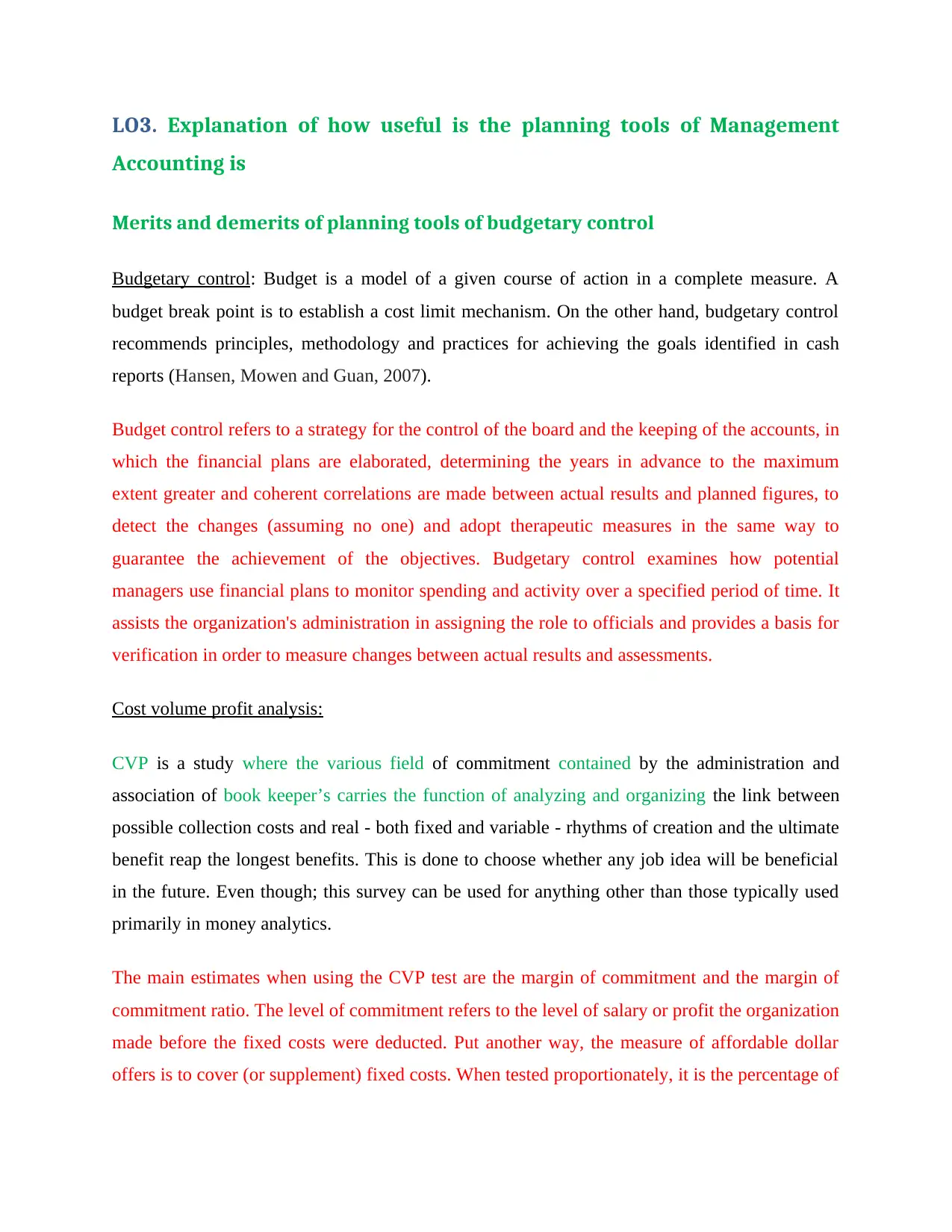
LO3. Explanation of how useful is the planning tools of Management
Accounting is
Merits and demerits of planning tools of budgetary control
Budgetary control: Budget is a model of a given course of action in a complete measure. A
budget break point is to establish a cost limit mechanism. On the other hand, budgetary control
recommends principles, methodology and practices for achieving the goals identified in cash
reports (Hansen, Mowen and Guan, 2007).
Budget control refers to a strategy for the control of the board and the keeping of the accounts, in
which the financial plans are elaborated, determining the years in advance to the maximum
extent greater and coherent correlations are made between actual results and planned figures, to
detect the changes (assuming no one) and adopt therapeutic measures in the same way to
guarantee the achievement of the objectives. Budgetary control examines how potential
managers use financial plans to monitor spending and activity over a specified period of time. It
assists the organization's administration in assigning the role to officials and provides a basis for
verification in order to measure changes between actual results and assessments.
Cost volume profit analysis:
CVP is a study where the various field of commitment contained by the administration and
association of book keeper’s carries the function of analyzing and organizing the link between
possible collection costs and real - both fixed and variable - rhythms of creation and the ultimate
benefit reap the longest benefits. This is done to choose whether any job idea will be beneficial
in the future. Even though; this survey can be used for anything other than those typically used
primarily in money analytics.
The main estimates when using the CVP test are the margin of commitment and the margin of
commitment ratio. The level of commitment refers to the level of salary or profit the organization
made before the fixed costs were deducted. Put another way, the measure of affordable dollar
offers is to cover (or supplement) fixed costs. When tested proportionately, it is the percentage of
Accounting is
Merits and demerits of planning tools of budgetary control
Budgetary control: Budget is a model of a given course of action in a complete measure. A
budget break point is to establish a cost limit mechanism. On the other hand, budgetary control
recommends principles, methodology and practices for achieving the goals identified in cash
reports (Hansen, Mowen and Guan, 2007).
Budget control refers to a strategy for the control of the board and the keeping of the accounts, in
which the financial plans are elaborated, determining the years in advance to the maximum
extent greater and coherent correlations are made between actual results and planned figures, to
detect the changes (assuming no one) and adopt therapeutic measures in the same way to
guarantee the achievement of the objectives. Budgetary control examines how potential
managers use financial plans to monitor spending and activity over a specified period of time. It
assists the organization's administration in assigning the role to officials and provides a basis for
verification in order to measure changes between actual results and assessments.
Cost volume profit analysis:
CVP is a study where the various field of commitment contained by the administration and
association of book keeper’s carries the function of analyzing and organizing the link between
possible collection costs and real - both fixed and variable - rhythms of creation and the ultimate
benefit reap the longest benefits. This is done to choose whether any job idea will be beneficial
in the future. Even though; this survey can be used for anything other than those typically used
primarily in money analytics.
The main estimates when using the CVP test are the margin of commitment and the margin of
commitment ratio. The level of commitment refers to the level of salary or profit the organization
made before the fixed costs were deducted. Put another way, the measure of affordable dollar
offers is to cover (or supplement) fixed costs. When tested proportionately, it is the percentage of
⊘ This is a preview!⊘
Do you want full access?
Subscribe today to unlock all pages.

Trusted by 1+ million students worldwide
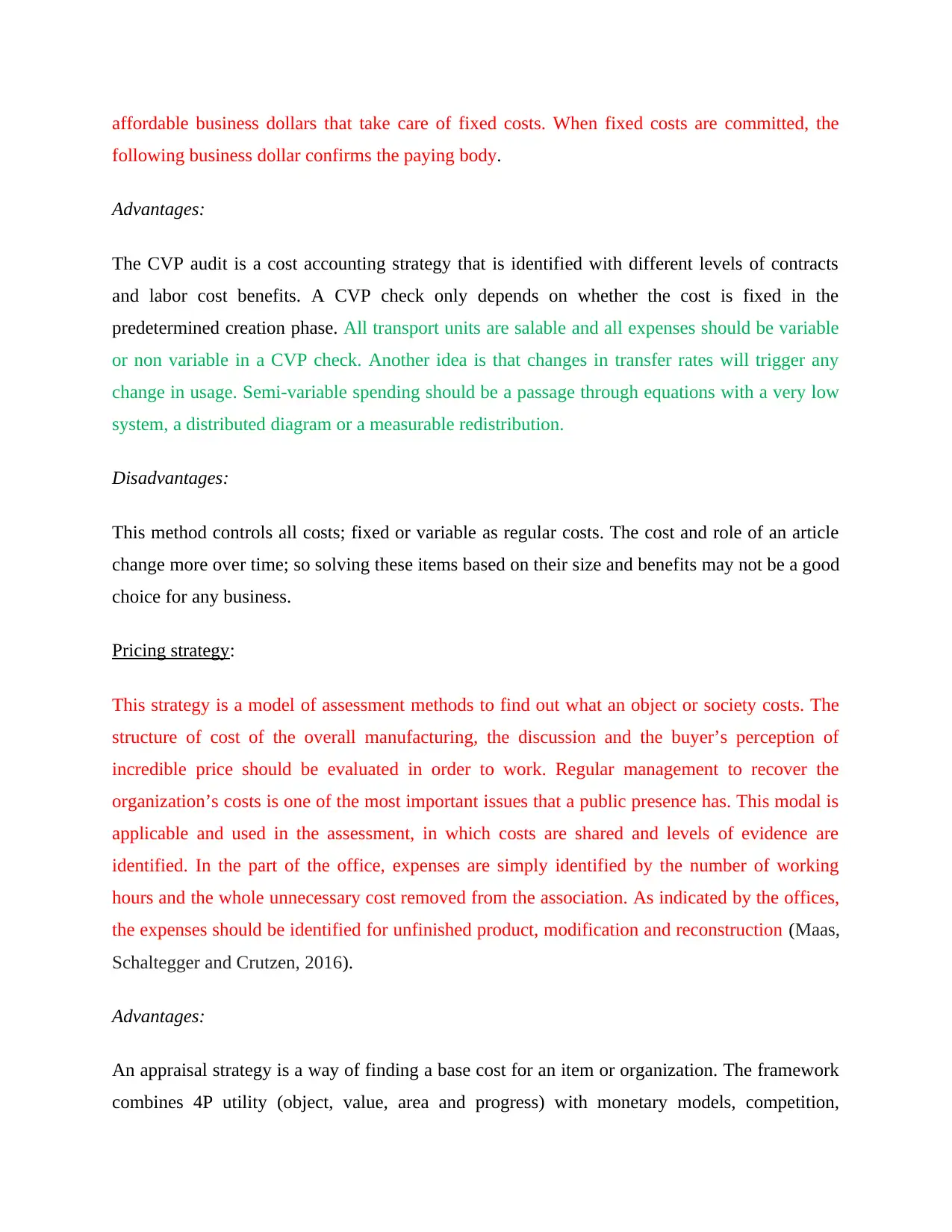
affordable business dollars that take care of fixed costs. When fixed costs are committed, the
following business dollar confirms the paying body.
Advantages:
The CVP audit is a cost accounting strategy that is identified with different levels of contracts
and labor cost benefits. A CVP check only depends on whether the cost is fixed in the
predetermined creation phase. All transport units are salable and all expenses should be variable
or non variable in a CVP check. Another idea is that changes in transfer rates will trigger any
change in usage. Semi-variable spending should be a passage through equations with a very low
system, a distributed diagram or a measurable redistribution.
Disadvantages:
This method controls all costs; fixed or variable as regular costs. The cost and role of an article
change more over time; so solving these items based on their size and benefits may not be a good
choice for any business.
Pricing strategy:
This strategy is a model of assessment methods to find out what an object or society costs. The
structure of cost of the overall manufacturing, the discussion and the buyer’s perception of
incredible price should be evaluated in order to work. Regular management to recover the
organization’s costs is one of the most important issues that a public presence has. This modal is
applicable and used in the assessment, in which costs are shared and levels of evidence are
identified. In the part of the office, expenses are simply identified by the number of working
hours and the whole unnecessary cost removed from the association. As indicated by the offices,
the expenses should be identified for unfinished product, modification and reconstruction (Maas,
Schaltegger and Crutzen, 2016).
Advantages:
An appraisal strategy is a way of finding a base cost for an item or organization. The framework
combines 4P utility (object, value, area and progress) with monetary models, competition,
following business dollar confirms the paying body.
Advantages:
The CVP audit is a cost accounting strategy that is identified with different levels of contracts
and labor cost benefits. A CVP check only depends on whether the cost is fixed in the
predetermined creation phase. All transport units are salable and all expenses should be variable
or non variable in a CVP check. Another idea is that changes in transfer rates will trigger any
change in usage. Semi-variable spending should be a passage through equations with a very low
system, a distributed diagram or a measurable redistribution.
Disadvantages:
This method controls all costs; fixed or variable as regular costs. The cost and role of an article
change more over time; so solving these items based on their size and benefits may not be a good
choice for any business.
Pricing strategy:
This strategy is a model of assessment methods to find out what an object or society costs. The
structure of cost of the overall manufacturing, the discussion and the buyer’s perception of
incredible price should be evaluated in order to work. Regular management to recover the
organization’s costs is one of the most important issues that a public presence has. This modal is
applicable and used in the assessment, in which costs are shared and levels of evidence are
identified. In the part of the office, expenses are simply identified by the number of working
hours and the whole unnecessary cost removed from the association. As indicated by the offices,
the expenses should be identified for unfinished product, modification and reconstruction (Maas,
Schaltegger and Crutzen, 2016).
Advantages:
An appraisal strategy is a way of finding a base cost for an item or organization. The framework
combines 4P utility (object, value, area and progress) with monetary models, competition,
Paraphrase This Document
Need a fresh take? Get an instant paraphrase of this document with our AI Paraphraser
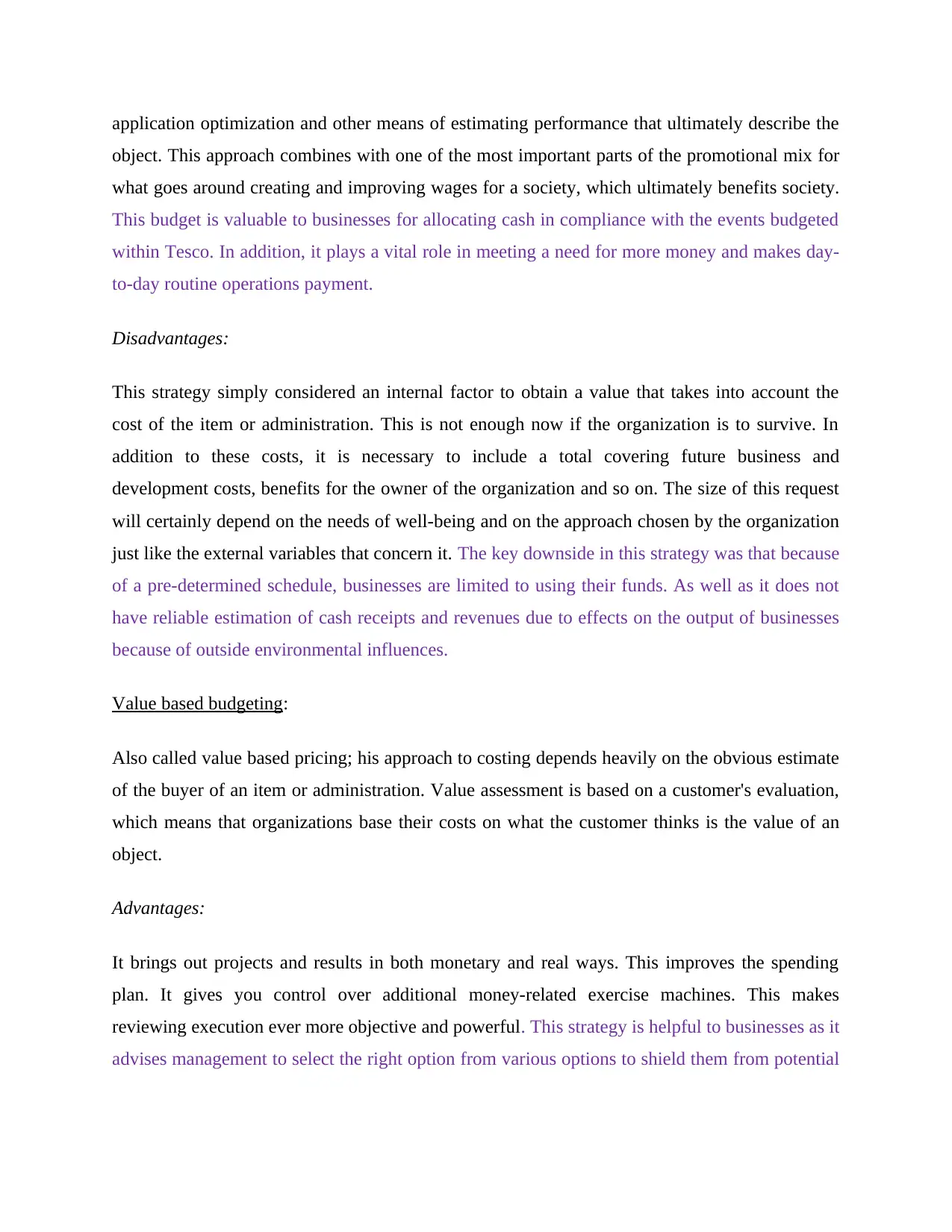
application optimization and other means of estimating performance that ultimately describe the
object. This approach combines with one of the most important parts of the promotional mix for
what goes around creating and improving wages for a society, which ultimately benefits society.
This budget is valuable to businesses for allocating cash in compliance with the events budgeted
within Tesco. In addition, it plays a vital role in meeting a need for more money and makes day-
to-day routine operations payment.
Disadvantages:
This strategy simply considered an internal factor to obtain a value that takes into account the
cost of the item or administration. This is not enough now if the organization is to survive. In
addition to these costs, it is necessary to include a total covering future business and
development costs, benefits for the owner of the organization and so on. The size of this request
will certainly depend on the needs of well-being and on the approach chosen by the organization
just like the external variables that concern it. The key downside in this strategy was that because
of a pre-determined schedule, businesses are limited to using their funds. As well as it does not
have reliable estimation of cash receipts and revenues due to effects on the output of businesses
because of outside environmental influences.
Value based budgeting:
Also called value based pricing; his approach to costing depends heavily on the obvious estimate
of the buyer of an item or administration. Value assessment is based on a customer's evaluation,
which means that organizations base their costs on what the customer thinks is the value of an
object.
Advantages:
It brings out projects and results in both monetary and real ways. This improves the spending
plan. It gives you control over additional money-related exercise machines. This makes
reviewing execution ever more objective and powerful. This strategy is helpful to businesses as it
advises management to select the right option from various options to shield them from potential
object. This approach combines with one of the most important parts of the promotional mix for
what goes around creating and improving wages for a society, which ultimately benefits society.
This budget is valuable to businesses for allocating cash in compliance with the events budgeted
within Tesco. In addition, it plays a vital role in meeting a need for more money and makes day-
to-day routine operations payment.
Disadvantages:
This strategy simply considered an internal factor to obtain a value that takes into account the
cost of the item or administration. This is not enough now if the organization is to survive. In
addition to these costs, it is necessary to include a total covering future business and
development costs, benefits for the owner of the organization and so on. The size of this request
will certainly depend on the needs of well-being and on the approach chosen by the organization
just like the external variables that concern it. The key downside in this strategy was that because
of a pre-determined schedule, businesses are limited to using their funds. As well as it does not
have reliable estimation of cash receipts and revenues due to effects on the output of businesses
because of outside environmental influences.
Value based budgeting:
Also called value based pricing; his approach to costing depends heavily on the obvious estimate
of the buyer of an item or administration. Value assessment is based on a customer's evaluation,
which means that organizations base their costs on what the customer thinks is the value of an
object.
Advantages:
It brings out projects and results in both monetary and real ways. This improves the spending
plan. It gives you control over additional money-related exercise machines. This makes
reviewing execution ever more objective and powerful. This strategy is helpful to businesses as it
advises management to select the right option from various options to shield them from potential
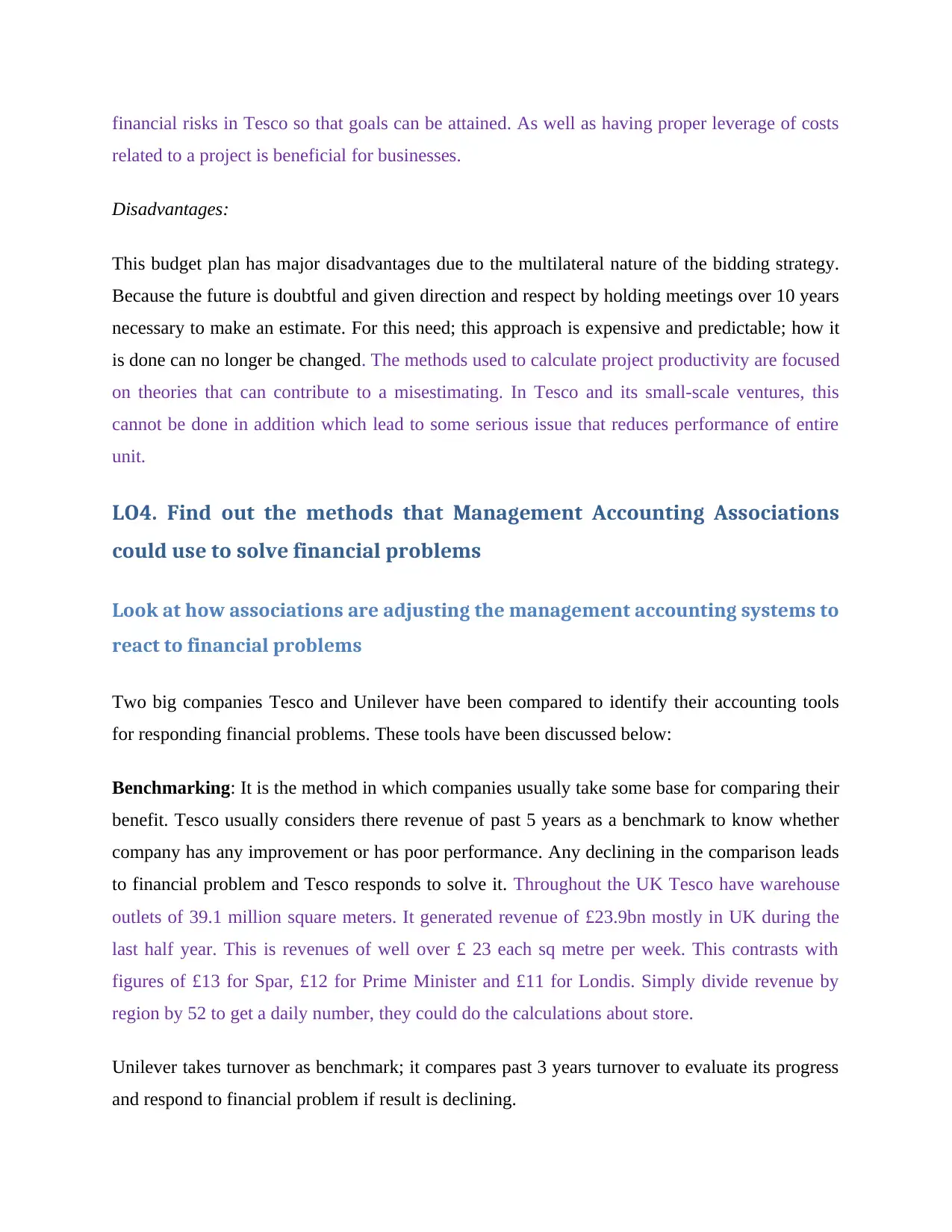
financial risks in Tesco so that goals can be attained. As well as having proper leverage of costs
related to a project is beneficial for businesses.
Disadvantages:
This budget plan has major disadvantages due to the multilateral nature of the bidding strategy.
Because the future is doubtful and given direction and respect by holding meetings over 10 years
necessary to make an estimate. For this need; this approach is expensive and predictable; how it
is done can no longer be changed. The methods used to calculate project productivity are focused
on theories that can contribute to a misestimating. In Tesco and its small-scale ventures, this
cannot be done in addition which lead to some serious issue that reduces performance of entire
unit.
LO4. Find out the methods that Management Accounting Associations
could use to solve financial problems
Look at how associations are adjusting the management accounting systems to
react to financial problems
Two big companies Tesco and Unilever have been compared to identify their accounting tools
for responding financial problems. These tools have been discussed below:
Benchmarking: It is the method in which companies usually take some base for comparing their
benefit. Tesco usually considers there revenue of past 5 years as a benchmark to know whether
company has any improvement or has poor performance. Any declining in the comparison leads
to financial problem and Tesco responds to solve it. Throughout the UK Tesco have warehouse
outlets of 39.1 million square meters. It generated revenue of £23.9bn mostly in UK during the
last half year. This is revenues of well over £ 23 each sq metre per week. This contrasts with
figures of £13 for Spar, £12 for Prime Minister and £11 for Londis. Simply divide revenue by
region by 52 to get a daily number, they could do the calculations about store.
Unilever takes turnover as benchmark; it compares past 3 years turnover to evaluate its progress
and respond to financial problem if result is declining.
related to a project is beneficial for businesses.
Disadvantages:
This budget plan has major disadvantages due to the multilateral nature of the bidding strategy.
Because the future is doubtful and given direction and respect by holding meetings over 10 years
necessary to make an estimate. For this need; this approach is expensive and predictable; how it
is done can no longer be changed. The methods used to calculate project productivity are focused
on theories that can contribute to a misestimating. In Tesco and its small-scale ventures, this
cannot be done in addition which lead to some serious issue that reduces performance of entire
unit.
LO4. Find out the methods that Management Accounting Associations
could use to solve financial problems
Look at how associations are adjusting the management accounting systems to
react to financial problems
Two big companies Tesco and Unilever have been compared to identify their accounting tools
for responding financial problems. These tools have been discussed below:
Benchmarking: It is the method in which companies usually take some base for comparing their
benefit. Tesco usually considers there revenue of past 5 years as a benchmark to know whether
company has any improvement or has poor performance. Any declining in the comparison leads
to financial problem and Tesco responds to solve it. Throughout the UK Tesco have warehouse
outlets of 39.1 million square meters. It generated revenue of £23.9bn mostly in UK during the
last half year. This is revenues of well over £ 23 each sq metre per week. This contrasts with
figures of £13 for Spar, £12 for Prime Minister and £11 for Londis. Simply divide revenue by
region by 52 to get a daily number, they could do the calculations about store.
Unilever takes turnover as benchmark; it compares past 3 years turnover to evaluate its progress
and respond to financial problem if result is declining.
⊘ This is a preview!⊘
Do you want full access?
Subscribe today to unlock all pages.

Trusted by 1+ million students worldwide
1 out of 21
Related Documents
Your All-in-One AI-Powered Toolkit for Academic Success.
+13062052269
info@desklib.com
Available 24*7 on WhatsApp / Email
![[object Object]](/_next/static/media/star-bottom.7253800d.svg)
Unlock your academic potential
Copyright © 2020–2025 A2Z Services. All Rights Reserved. Developed and managed by ZUCOL.



